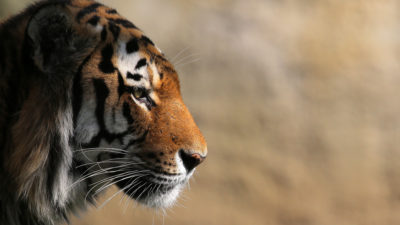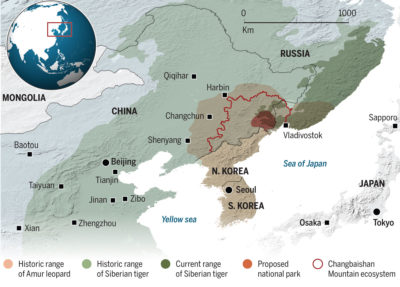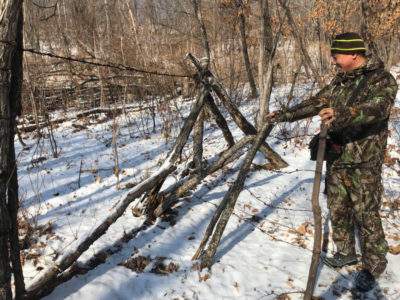Small villages of a dozen or so houses emerge around each bend in the highway that cuts through the snow-laced foothills of the Changbai Mountains. Farmers, mainly old men, putt-putt by on motorized carts laden with birch branches, steam pouring from their mouths in the single-digit cold. Bronze-colored cattle graze, and large, black pigs root between rows of corn stubble.
It is early January, and I am traveling with a carload of Chinese volunteers who will spend much of the day in the forest looking for traps and snares, which locals set to catch roe deer and boar. These are the main prey of the rare, big cats — both Siberian tigers and Amur leopards — that roam these hills, but the traps occasionally ensnare one of the critically endangered felines. Our goal is to find and dismantle the snares.
Over three days, several groups like ours hike over hill and valley, sometimes coming within five miles of the North Korean border. One group finds 11 traps one day, while ours finds none. On other days our group comes across only a few smaller snares. This is a good sign, Chinese forest service officials say, as it appears local hunters are putting out fewer traps.
We are in the heart of a 5,790-square-mile expanse stretching across the provinces of Jilin and Heilongjiang, a tongue of land in northeastern China wedged between North Korea to the south and Russia to the northeast. By the end of 2020, this area will become one of roughly ten national parks that China has pledged to establish over the next few years, as part of President Xi Jinping’s signature policy of creating an “Ecological Civilization.” The primary goal in the Changbai Mountain preserve: to give the Siberian tiger and Amur leopard room to roam.
CLICK TO ENLARGE - China's new national park for Siberian tigers and Amur leopards borders Russia and North Korea. Map by A. Cuadra/Science. Reprinted with permission from AAAS.
At least 27 Siberian tigers and 42 Amur leopards live in the region where the national park will be established, according to Feng Limin, a biologist from Beijing Normal University. One of the originators of the idea for the national park, Feng has over the past several years been actively tracking tiger and leopard populations in Jilin and Heilongjiang using motion-activated cameras. Feng and his colleagues have counted and identified the individual big cats by the different striped patterns on the tigers and the varied arrangements of spots on the leopards.
These magnificent animals are part of remaining — and highly elusive —populations of Siberian tigers and Amur leopards in northeastern Asia. Siberian tigers, which can weigh more than 600 pounds and grow to more than 10 feet in length, now number about 550 in the wild, with the vast majority hanging on in the taiga of the Russian Far East. Amur leopards, which can weigh more than 100 pounds and grow to more than four feet in length, are now estimated to number roughly 80 in the wild, according to Dale Miquelle, a Vladivostok-based biologist with the Wildlife Conservation Society and a leading expert on the two cat species.
After teetering on the verge of extinction, populations of both species — especially the Siberian tiger (Panthera tigris tigris) — are slowly rebounding. That invests the creation of China’s Northeast Tiger and Leopard National Park, which will be 60 percent larger than Yellowstone National Park, with added significance. The park’s location is critical, biologists say, as it will provide a refuge for tigers and leopards in China — where dense human populations have left the big cats more hemmed in than in sparsely populated Russian regions — and will enable the animals to roam between the two countries.
The fate of Siberian tigers and Amur leopards in neighboring North Korea remains unclear.
The fate of Siberian tigers and Amur leopards (Panthera pardus orientalis) in neighboring North Korea remains unclear. But researchers fear that few of the animals still survive in that isolated nation, as most of the trees in the mountains that extend into North Korea have been cut down for firewood, limiting cover for the big cats and their prey.
International conservation groups are hailing the creation of the new Chinese tiger park, which was announced last year.
“Nearly all of these animals that occur in China, both tigers and leopards, occur within the boundaries of the newly proposed park,” said Miquelle. “Compared to when I started working on tigers in China in 1998, this represents huge progress and should not be underestimated. Yes, there are still lots of people in the park, [but] we are hopeful that relocation programs are planned strategically to maximize space for tigers and minimize impact for humans.”
Miquelle believes the area could conceivably support a population of around 75 Siberian tigers — about triple today’s numbers. “In a world where there only about 3,500 tigers left,” said Miquelle, “that is a very significant contribution to the global population, and would tie into a much larger population on the Russian border.”
At least 42 Amur leopards, such as this one photographed at a camera trap, live within the boundaries of the proposed new national park. Wildlife Conservation Society-China
How fast the big cats can rebound will depend on how well the ecosystem in China is repaired, Miquelle and Feng say.
To create enough habitat for the big cats and their prey, Chinese officials are planning to relocate 70,000 to 80,000 local residents either outside of the park or into a few settlements within the park’s boundaries. How this large-scale relocation will be accomplished remains uncertain, but China’s authortarian government has a history of displacing large numbers of people for projects such as the Three Gorges Dam.
Three years ago, the government implemented a logging ban in the region that is expected to bring back some of the Amur linden, Korean pine, birch, scrub oak, and elm that make up the dense, temperate rainforests and woodlands favored by Siberian tigers. Mining projects also are being banned.
“If the deer and the wild boar increase and reach a very high level, then the number [of tigers and leopards] could be much more,” Feng said. “In India, the tigers need a smaller range because they have a lot of prey. Here, there is not as much prey. If in the next few years we can decrease human activity and reduce cattle grazing, this will increase the overall quality of the ecosystem.”
Poaching and trapping have already been prohibited, so a key goal now is limiting human interaction with the big cats and providing them a wide corridor into Russia.
To create enough habitat for the big cats and their prey, Chinese officials are planning to relocate 75,000 local residents.
Perhaps half of the roughly 75,000 local residents will be pushed to three or four larger settlements within the park area and others moved to cities outside of it. Some will likely take their compensation from the government and move away, while others will remain in these small towns and shift into the tourist economy. Locals here are a mix of ethnic Korean, Manchu, and Han Chinese, mainly farmers or workers in nearby cities. The men have long set traps for deer, boar, and smaller animals in the wintertime, sometimes putting tigers or leopards at risk.
Li Ying, formerly with the Wildlife Conservation Society and now researching a Ph.D. on protecting tiger habitat, has started a nonprofit group called Sustainable Network Society to work with locals in the core area of the future park. She has conducted more than 200 interviews with villagers, trying to understand their views on conservation and the tigers and leopards.
Li is creating an education plan that can be disseminated in villages and schools, stressing the importance of conservation and explaining how saving the deer and boar can help save tigers and leopards. She is also working on plans to help local residents create environmentally friendly jobs such as organic farming, something that could help move farmers away from raising cattle and keep some of them on their land.
“If we can change the way people make a living and the lifestyle of the local people over time, this is the most crucial factor,” says Yang Weihe, from the Wildlife Conservation Society office in nearby Hunchun.
Li Dongwei of the Chinese forest service stands by a fence that currently separates tiger and leopard habitat from nearby farms. Michael Standaert/Yale e360
Jilin’s forestry bureau says that scores of people have been dispatched to remove traps in recent months, with more than 30,000 snares already dismantled. Volunteers have come from Beijing, Harbin, and as far away as Shenzhen in the tropical south. Cai Wenhong — a massive, energetic man decked out in camouflage who took time off from his job as a toll booth operator to remove traps — gushes that the future national park will be larger than Yellowstone.
In addition to the volunteers, another 325 locals have been put on the government payroll as “eco-managers” tasked with looking for traps and educating fellow villagers about the importance of protecting wildlife.
As we drive to a new location to look for traps, Li Dongwei, a team leader for the forestry bureau says he’s only seen three tigers in his six years at the bureau. Two of those sightings were from a distance, but one was just a meter or two away. That close call came when a young tiger had apparently been caught in a snare and separated from its mother. It was too young to know how to hunt properly and had been hanging around a village when Li got the call. Rangers tried to lure the tiger away from the village with a sheep carcass, but it had trouble feeding on it and eventually slinked back into the forest, where rangers believe it likely died.
“We know that both tigers and leopards have been killed by snares,” says Miquelle. “It is relatively rare, but it happens. And when you have a population [in an area] of 10 or 20 animals, the loss of a single breeding female is a huge setback.”
Black market profits for tiger parts — including the skin, gall bladder, and penis — can be enticing.
Most locals are not specifically hunting for tigers or leopards. But black market profits for tiger parts — including the skin, gall bladder, and penis, which is erroneously believed to enhance virility — can be enticing. While Miquelle didn’t have an estimate on how much a Chinese poacher could get for a tiger, in other countries people have been paid tens of thousands of dollars for the skin and body parts — many times what a poor Chinese laborer can earn in a year. The last time a person from northeast China was caught with a Siberian tiger carcass, about seven years ago, the man was jailed for five years, forestry officials said.
“Until villagers are told why they should stop [trapping], and understand there are serious consequences for continuing, this problem will not be resolved,” Miquelle said.
It will take time, even beyond 2020, to solidify the foundations of the Northeast Tiger and Leopard National Park, says Feng. But he is optimistic about the park’s success if the right balance of protection can be struck and human impacts are limited. This will be particularly important as tourist number grow following the creation of the park.
“The park is not only for tigers — the whole system, the region’s unique temperate forest, needs to be protected,” says Feng.






